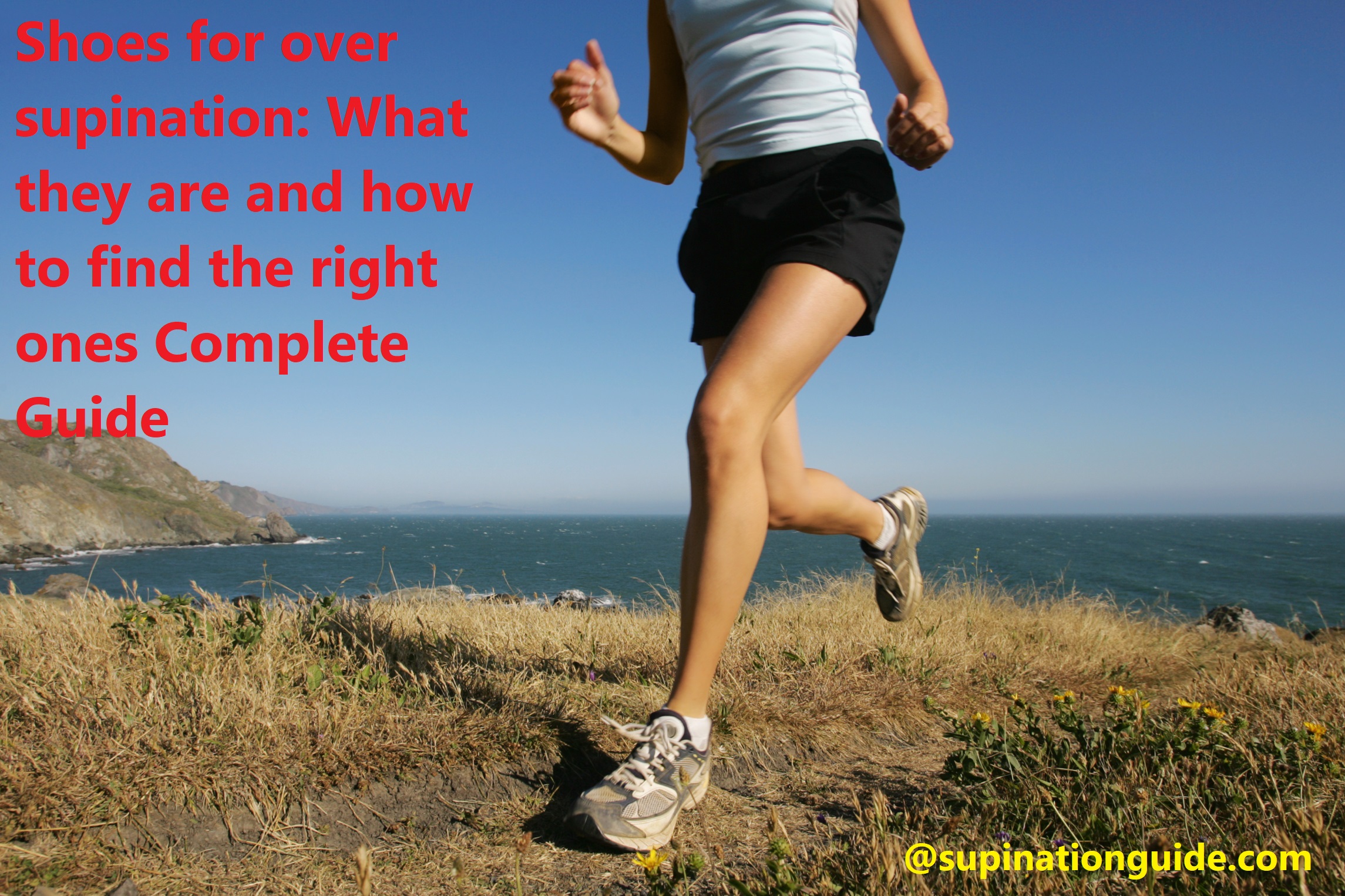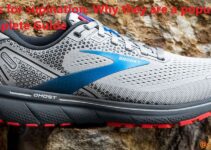Do you suffer from over-supination when walking or running? You’re not alone. Keeping your feet comfortable and protected is essential for exerting yourself daily.
In this article, you will learn what shoes for over-supination are and how to find the perfect pair for you. Get ready to learn the secrets of finding optimal support!
The perfect fit for a shoe is hard to find, but it’s even more difficult if you have over supination. This condition occurs when your foot rolls outward (or “supines”) too much when you walk or run. People with over supination need to focus on cushioning and shock absorption as these shoes will help your feet work better as you move.
Knowing what over supination is and understanding its effects are the first steps in finding the shoe that will be most comfortable for you. Here’s what you need to know about what causes it, how it affects your feet and the type of shoe that can provide the best support for this condition. With this guide, you should have no problem finding a pair of shoes that allows you to enjoy a snug fit without aggravating your feet.
Definition of over supination
Supination is the natural gait that takes place when a person’s feet roll outward, away from the midline of the body. Over supination happens when an individual’s feet rolls away more than it should, which can lead to potential health problems if not addressed.
When over supination occurs, excessive pressure is placed on the outside of a person’s heel and arch with every step they take. This pressure can cause pain, instability, and earlier-than-normal fatigue for those who suffer from it. Common causes of over supination include people who have low or flat arches, those who have worn shoes that have become worn down or stretched out over time, and people who participate in high-impact activities like running or basketball.
In order to address this problem, it is important to identify and purchase shoes specifically designed for over supination. These shoes are often labeled as “stability” or “motion control” shoes and are made with features aimed at correcting or preventing too much rolling outwards with each step taken. Generally speaking, these shoes feature increased padding in the heels; combined with a slightly raised arch support and extra stability components throughout the sole of the shoe that help guide your foot back into correct alignment with each stride you take.

Importance of wearing the right shoes for over supination
Having feet that over supinate can make certain activities uncomfortable and difficult. This is why it’s important to wear the right shoes when dealing with this condition—shoes that are designed specifically for those suffering from over supination can help ensure a more comfortable and successful experience. Not only can the right shoe provide needed support and cushioning, but the appropriate level of stability as well.
When shopping for shoes to help with this particular condition, there are a few key features to keep in mind in order to find the best pair for your individual needs:
- Best fit: since you’re dealing with an extra strong outward roll of your foot when walking, it’s important to find a pair of shoes that fits snugly around your foot without being too tight or too loose. Ankle stabilizers and arch supports might also be necessary elements for an ideal fit.
- Flexibility matters: although stability is essential, you don’t want a shoe that is too rigid, as this can cause further discomfort. Look for shoes constructed from flexible materials such as leather or canvas, or those with additional cushioning features in the heel and midsole areas.
- Trail running & cross training shoes: these might be better suited if you anticipate doing more active activities such as running or playing sports. Extra toe space as well as more stability should be kept in mind when choosing these types of shoes—they also should have additional cushioning features near key areas such as on either side of the heel area and near the toes to reduce stress on those areas when engaging in fast-paced activities.
Understanding Over Supination
Over supination, also known as underpronation, is a gait abnormality in which the foot does not roll inward enough. As a result, when running and walking, the heel and toes on the outside of the foot take longer to come in contact with the ground. This can cause particles from the ground to remain beneath the skin for longer periods of time. Furthermore, it can lead to pain in feet and legs due to an uneven gait.
To remedy over supination, finding shoes that provide stability is essential. Shoes for over supination need to be shock absorbent to protect your feet from strenuous activities such as running. Additionally, they need arch support so as to properly distribute weight onto your foot when walking or running; this helps avoid pains in your lower extremities while still allowing your feet natural movement to develop muscles evenly.
When looking for suitable shoes for over supination, be sure to get ones that fit snugly around your midfoot yet don’t cause any discomfort when you move around – there should be 1/2 inch of space between your big toe and end of the shoe. Also make sure they don’t compress too much; you don’t want them hindering your ability to move effectively or comfortably during exercises or everyday life. Finally, double check that everything conforms correctly from heel-to-toe so you benefit from adequate cushioning and maximum stability throughout each step.
Causes of over supination
Over supination is a condition caused by weak foot muscles and connective tissues. These weakened muscles and tissues are unable to properly support the arch, resulting in the foot rolling too far outward when walking or running. Over supination can lead to injury and pain and can even affect the delicate tendon structure of your feet. It is important to choose shoes that help address this issue correctly so you can keep pain at bay while remaining comfortable.
When you have over supination, it’s important to know what types of shoes can help manage the condition before you start shopping for a new pair. There are certain features that make certain shoes better equipped to manage over supination than others, such as extra cushioning and arch support, thicker soles for added shock absorption, and stability features tailored specifically for runners who tend to experience over pronation or over supination. It’s also important to select shoes made from lightweight materials with tight-knit uppers that prevent your feet from slipping around inside them during activity.
Symptoms of over supination
Over supination, also known as under-pronation, is a type of abnormal foot motion in which the foot doesn’t roll inward far enough when a person walks. With over pronation, the foot usually remains too rigid or straight while walking or running. This can cause a number of problems ranging from discomfort to reactive arthritis and even Bunions.
Symptoms of over supination include:
- Pain and discomfort in the feet, ankles and lower legs
- An increase in shin splints
- Knee pain due to an imbalance in the natural pronation that allows for even distribution of weight on the leg muscles
- Painful calluses on the out side of your feet due to uperference with natural traction while moving your body through space
- Flat feet or arches falling over time
- Bunions caused by ligament looseness
- Painful bumps on your outside ankle bones as well as arch areas from inflexible motion
Risks of not addressing over supination
Not addressing over supination can have significant negative impacts on an individual’s overall foot health and mobility. Over supination leads to excess strain on certain muscles, tendons, and ligaments and can lead to serious medical conditions if left untreated.
Over pronation puts excessive pressure on the inner side of the foot, causing repetitive stress injuries in the feet such as plantar fasciitis, heel pain, arch pain, arch strain and Achilles tendon inflammation. In extreme cases it may even lead to permanent injury or disability.
Regularly wearing shoes that do not address over supination can also cause improper posture while walking or running leading to muscle soreness in the hips, back and leg areas. Therefore finding appropriate shoes that address over supination is essential for maintaining healthy foot care.
Features of Shoes for Over Supination
Shoes for over supination must have a specific set of features to provide the necessary support and cushioning needed by those with the condition. Many of these features are related to the material and construction style used in the shoe’s design. Generally, shoes for over supination should have a supportive midsole, adequate cushioning, and reinforced side panels.
The midsole should be made from a combination of materials for added stability when walking. This could include such materials as EVA foam, rubber, or air-cushioning technology. This type of cushioning is designed to absorb shock and reduce stress on the feet as they take each step.
Adequate cushioning is also important in shoes for over supination; most people prefer some element of padding (preferably memory foam) or air pockets under the heel and arch that helps to absorb shock better and keep feet feeling comfortable all day long. Additionally, it’s important that your shoes fit correctly; too loose or too tight can lead to foot pain or further injury.
Reinforced side panels provide extra protection against lateral motion when walking which reduces fatigue and discomfort resulting from over pronation issues. These panels can be crafted from rigid materials like leather or synthetic fiber reinforcements that are stitched along key areas of your foot’s arch providing an extra layer between your foot and ground contact surfaces resulting in improved breathability and comfort throughout your day.

Cushioning
Cushioning is an important factor when it comes to shopping for the right shoe for over supination. You want a shoe that provides the maximum cushioning to protect your feet from repeated pounding, especially if you are running or hiking. Shoes with extra cushioning help to reduce the strain and stress placed on the feet with each step. This also helps to absorb shock and minimize any impact on your joints.
Since over pronators put extra pressure on the outside of their feet as they move, cushioning along that area is important. Shoes with good cushioning usually include padded heel counters and absorbing materials in the midsole such as air, foam or gel inserts. Additionally, look for a tapered design that helps cradle your foot in place while still providing flexible movement – something crucial when shopping for shoes designed with over pronation in mind.
Arch support
Having the right arch support in shoes is a key factor for anyone prone to over supination. It is ideal for those with an over pronated foot arch, as it helps control the excessive inward rolling motion that occurs when you move. Generally, a firm midsole and cushioning under the ball of the foot will offer the best support.
There are several ways that manufacturers design their shoes to offer optimal support for those suffering from over supination. Many shoes are designed with a curved heel cup, which helps keep the heel in place while allowing it to move naturally at the same time. The sole should be wide and flexible enough to allow natural movement of the foot without twisting or causing discomfort. Shoes with dual density midsoles can also help reduce any shocks felt when running or walking. Moreover, shock absorbing soles and cushioning in areas of higher pressure such as at heel strike can help reduce pain associated with over pronation.
When selecting shoes for over supination, it is important to look out for certain features such as supportive uppers with materials like leather or synthetic fabrics designed to keep your feet secure and comfortable while providing flexibility, adequate cushioning and firmer midsoles which enable more lateral stability while still providing flexibility at both heel strike and toe-off points. Always try on different sizes to ensure you get a shoe that fits properly so you don’t experience any rubbing or irritation around sensitive areas like your ankles or heels. Finally, look for extra arch support if needed – most high quality running shoe stores can recommend appropriate insoles if required.
Stability
Stability shoes are designed to help people with a tendency to over-supinate (or under-pronate). People with over-supination have a very rigid foot strike, which can cause strain on the calf muscles and Achilles tendon. Stability shoes provide extra cushioning and support in the heel area, which can help reduce over-supination and protect the foot from injury while exercising. There are several key features to look for when choosing a stability shoe:
- Motion control – Stability shoes typically have more components on the sole that limit joint flexion, providing more stability for athletes who tend to oversupinate. This can help reduce extra strain placed on the foot during movement.
- Cushioning – Stability shoes typically have more cushioning than neutral models, helping absorb extra shock as you take each step.
- Supportive midsole – The midsole is usually made from polyurethane or EVA foam and is designed to provide added arch support and increased stability along with enhanced cushioning. A supportive midsole helps protect the foot from repetitive motion damage by providing an even landing platform while walking or running.
- Heel counter – A padded heel counter provides additional ankle support, reducing unnecessary strain placed on this delicate joint. It also helps provide extra support for athletes who tend to over supinate as they take each step.
Flexibility
Many people suffering from over supination need arch support and the precise cushioning to alleviate their symptoms. Shoes for over supination, thus, emphasize flexibility rather than stability. Opting for a flexible sole with cushioning instead of a stiff sole will reduce the amount of stress on your feet by allowing your feet to move naturally within the shoes, while distributing the impact evenly. The material should also be breathable so your feet won’t sweat and cause irritations or blisters.
Additionally, look out for shoes with deep heel cups as they provide better support and alignment of the ankle for those with over supination. Moreover, your toes should have enough room to fit without restrictions as cramped up toes can lead to hammertoes or clawed toes. As such, always make sure that you have room at least half a thumb-width from the tip of your big toe when trying out shoes before buying them.
Fit
One of the most important aspects to consider when shopping for shoes to help with overpronation is proper fit. Since your feet may be wider or longer than the standard sizes, you may want to look for shoes in wider or specialist sizes from footwear outlets.
You should also consider whether you need semi-custom orthotics, which are custom fitted insoles specifically designed for your foot shape and individual needs.
Your shoes must fit properly in order for them to provide the correct type of support, so it’s important to take all of these factors into consideration before making a purchase.
Conclusion
When shopping for shoes to aid with over supination, it is important to research the brands and types of shoes available. Many brands specialize in running and walking shoes designed for people with over pronated feet, so it is important to know what type of support you are looking for before you begin your search.
Additionally, look for features such as cushioning, arch support, and shock-absorbent materials that can help alleviate some of the pain associated with this condition.
Finally, visit a specialty store to ensure that the shoe fits correctly and provides the proper support needed. By doing your research and choosing the right shoe, you can help minimize the discomfort of over supination.

FAQ’s
What shoes should I look for in supination?
Shoes that provide cushioning and shock absorption are recommended for supinators. Look for shoes with a curved last and a neutral to slightly curved shape to encourage a more natural foot motion.
Do you need special shoes for supination?
Special shoes designed for supinators are not necessary, but shoes that provide cushioning, shock absorption, and support for the foot can help alleviate discomfort and prevent injuries.
What kind of support does an over supinator need in a shoe?
An over supinator needs shoes with good cushioning, shock absorption, and stability features, such as a slightly curved shape and firm midsole. Shoes with a wide toe box and good arch support can also be helpful.
What type of shoes should you recommend to a customer who is an underpronation or supination?
For customers who underpronate or supinate, it is recommended to choose shoes with good cushioning, shock absorption, and support. Neutral or slightly curved shoes are preferred over motion control or stability shoes.
What is the best way to correct supination of foot?
The best way to correct supination of the foot is to do exercises that strengthen the muscles of the foot and ankle. Wearing shoes with good support and cushioning can also help improve the foot’s natural motion.
Can supinators wear stability shoes?
Stability shoes can be worn by supinators, but it is important to choose shoes with a slightly curved shape and good cushioning to prevent excessive motion and discomfort.
Do supinators need arch support?
Supinators may benefit from shoes with good arch support to help distribute pressure evenly and prevent foot pain. However, it is not necessary for all supinators to have arch support in their shoes.
What causes foot supination?
Foot supination can be caused by several factors, including genetics, muscle weakness, tight muscles, and wearing shoes that do not fit properly.
Can supination cause balance problems?
Supination can cause balance problems and increase the risk of ankle sprains and other foot injuries. It is important to wear shoes with good support and to do exercises to strengthen the foot and ankle muscles.
Can you reverse supination?
Supination can be improved with exercises that strengthen the muscles of the foot and ankle and by wearing shoes that provide good support and cushioning. However, it may not be completely reversible in all cases.
See Also :
- Best sneakers for supination
- Best asics shoes for supination
- Best tennis shoes for supination
- Best walking shoes for supination
- Best womens running shoes for supination


